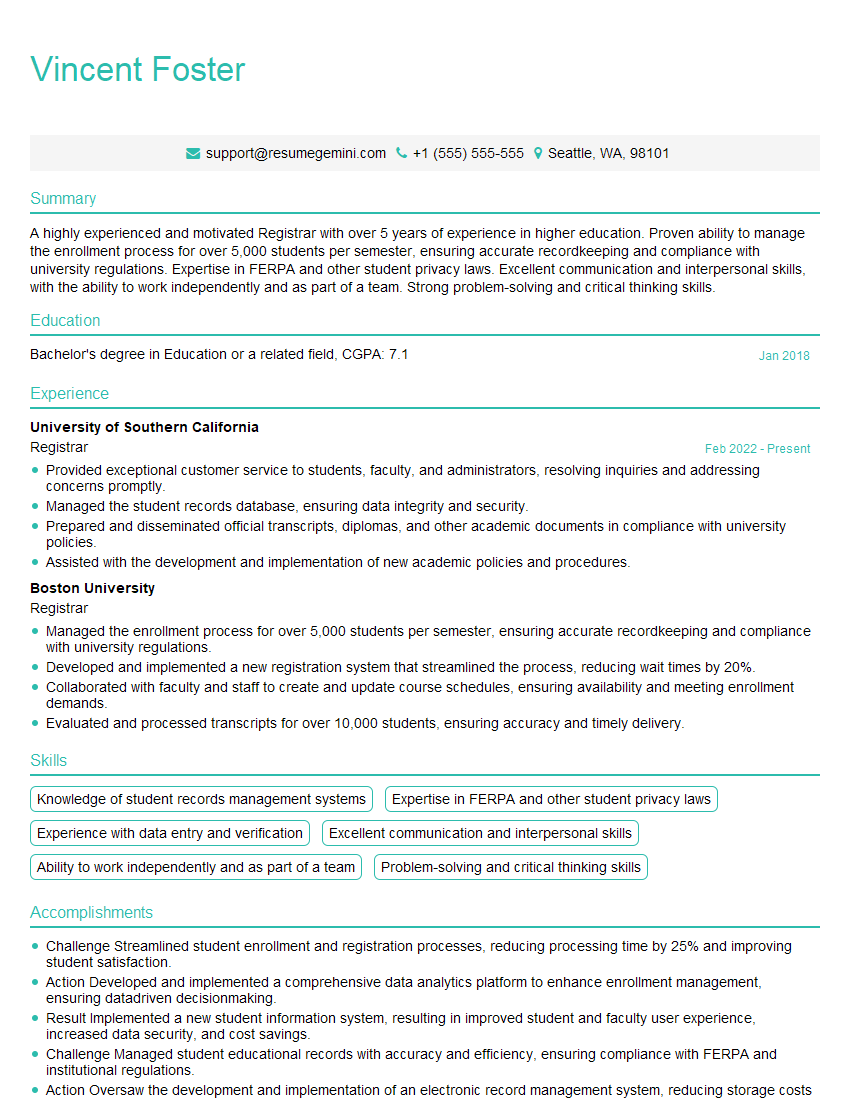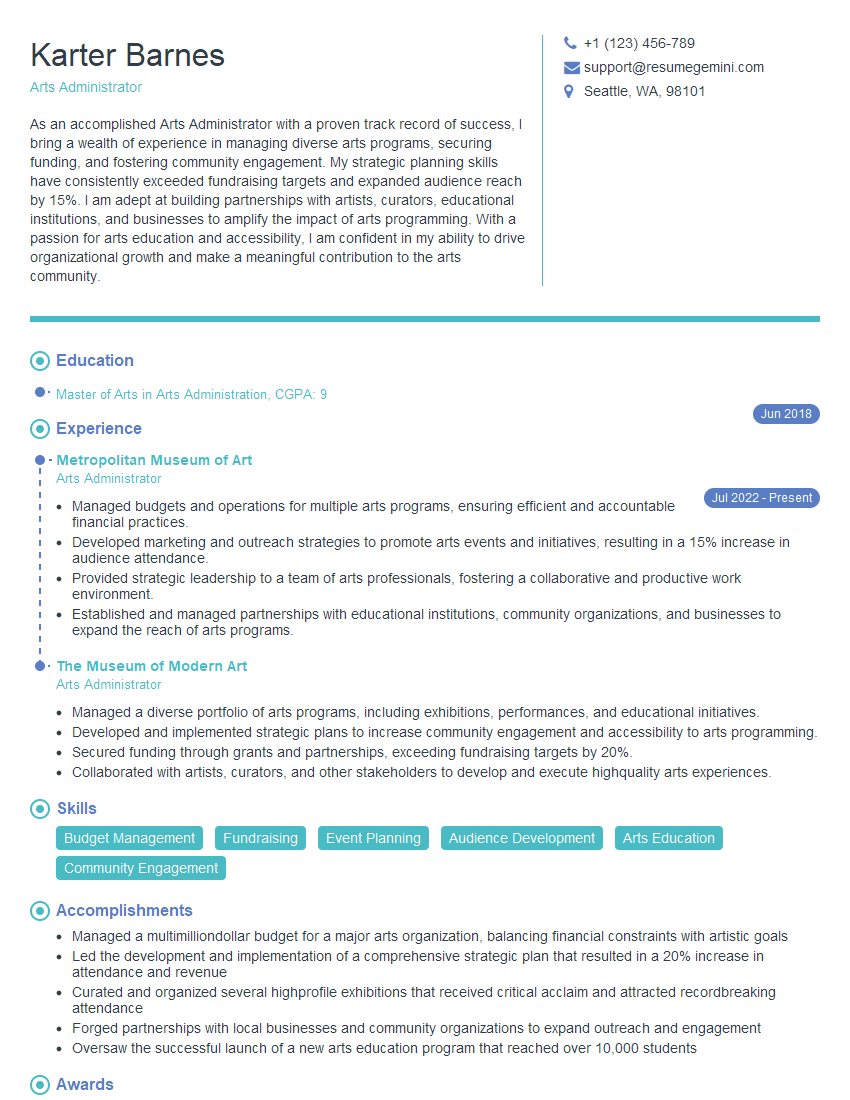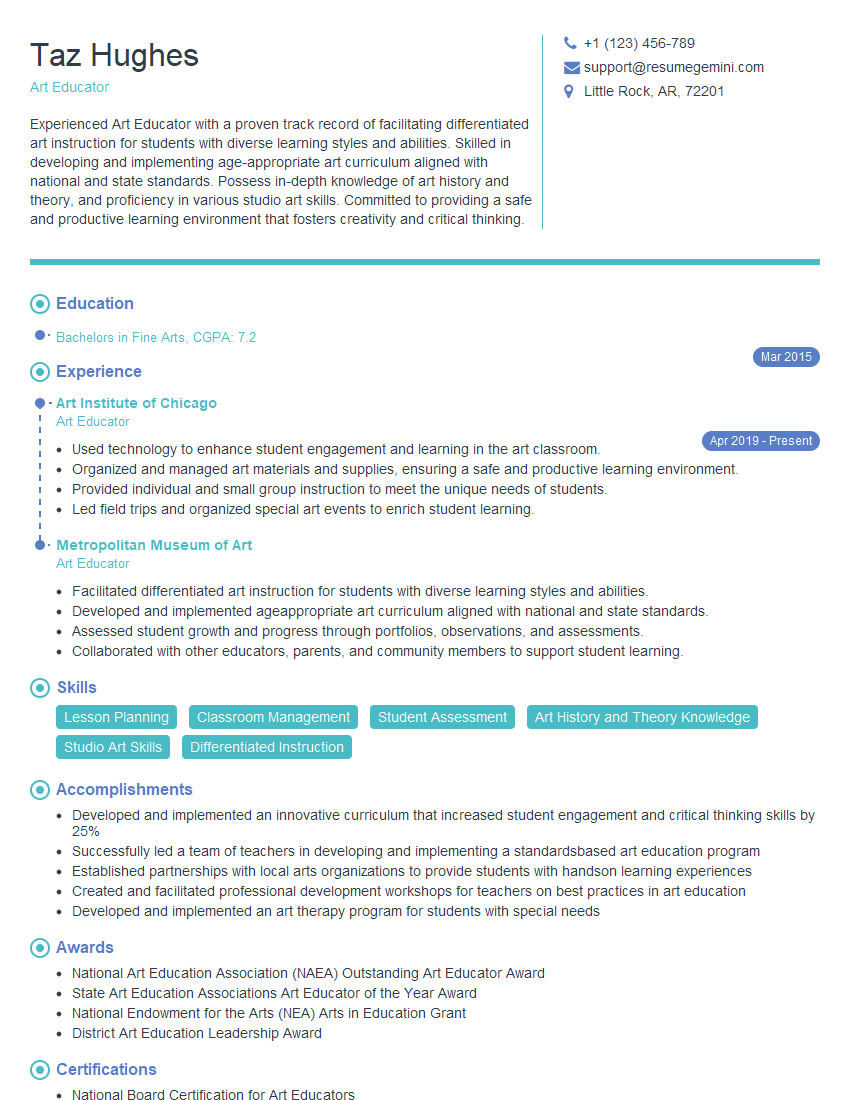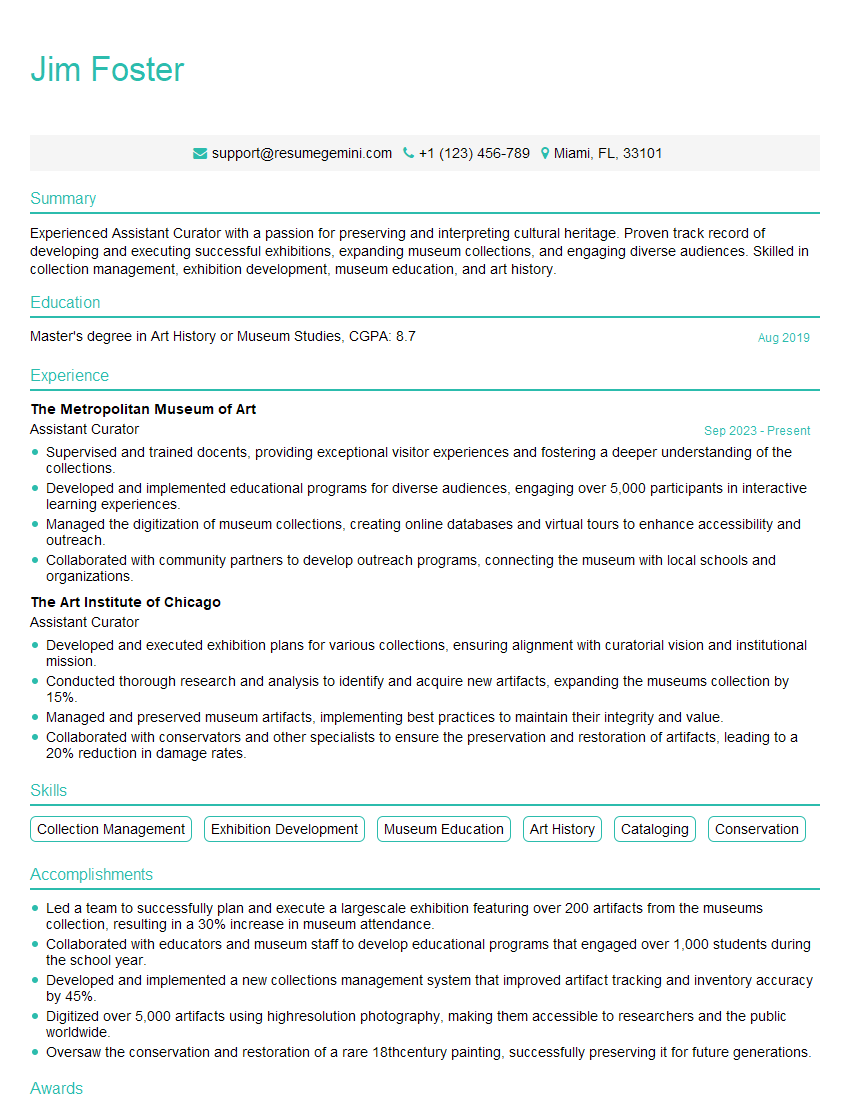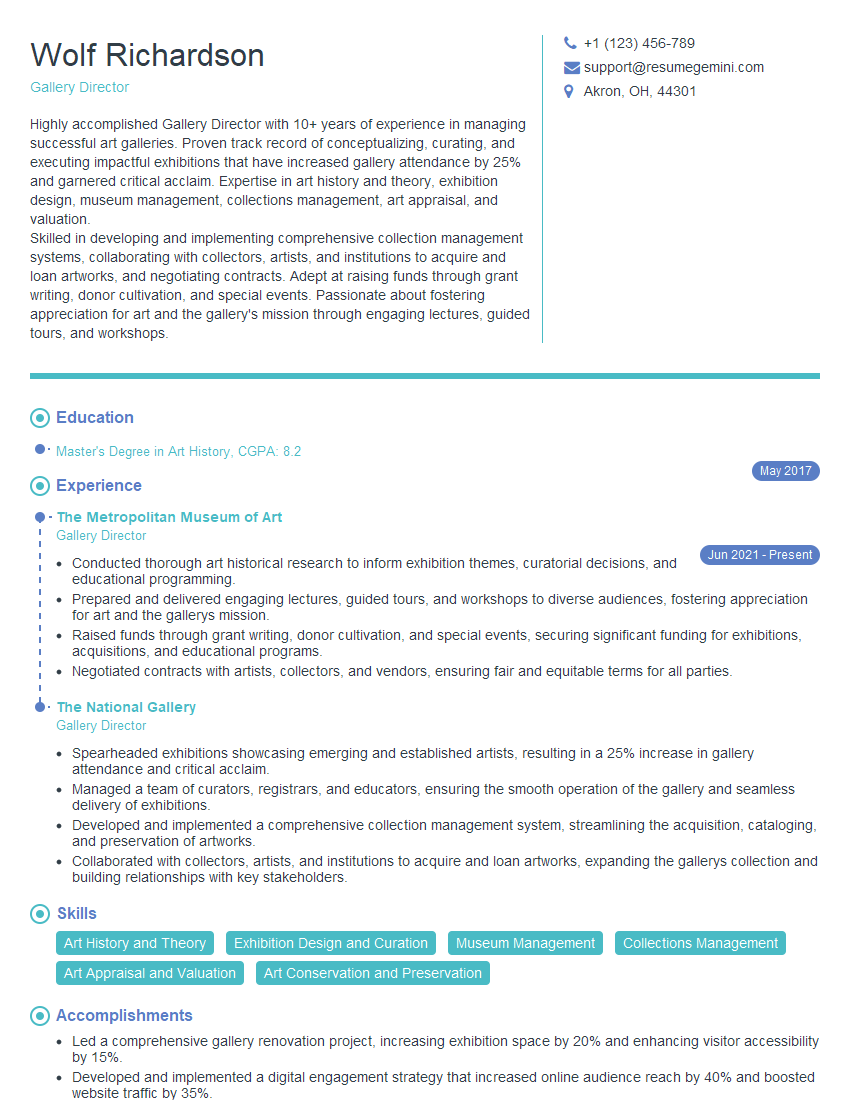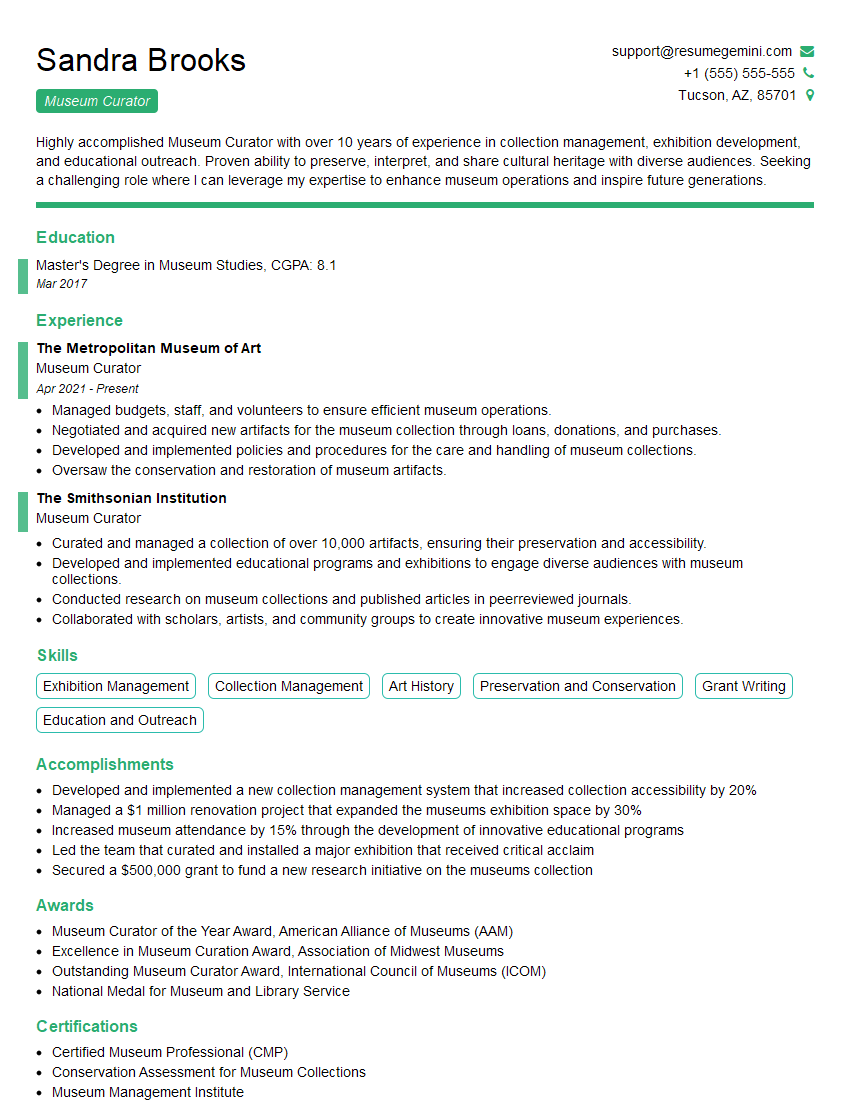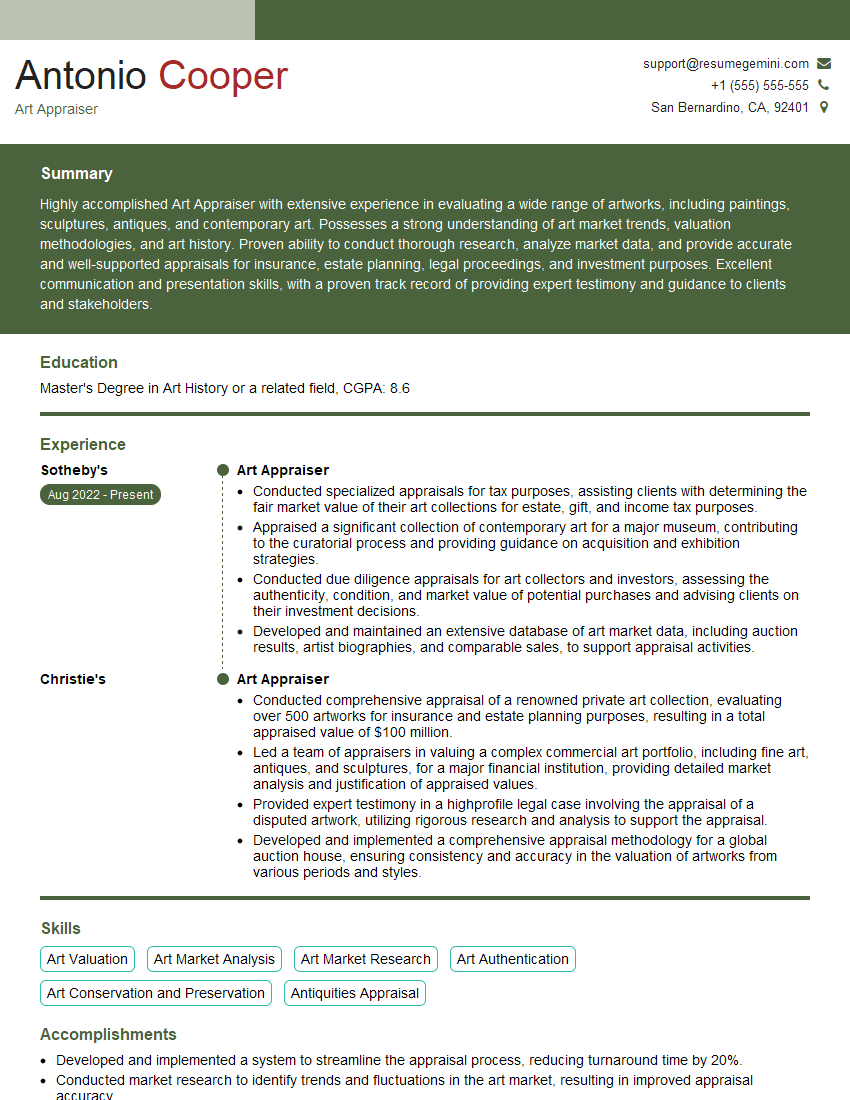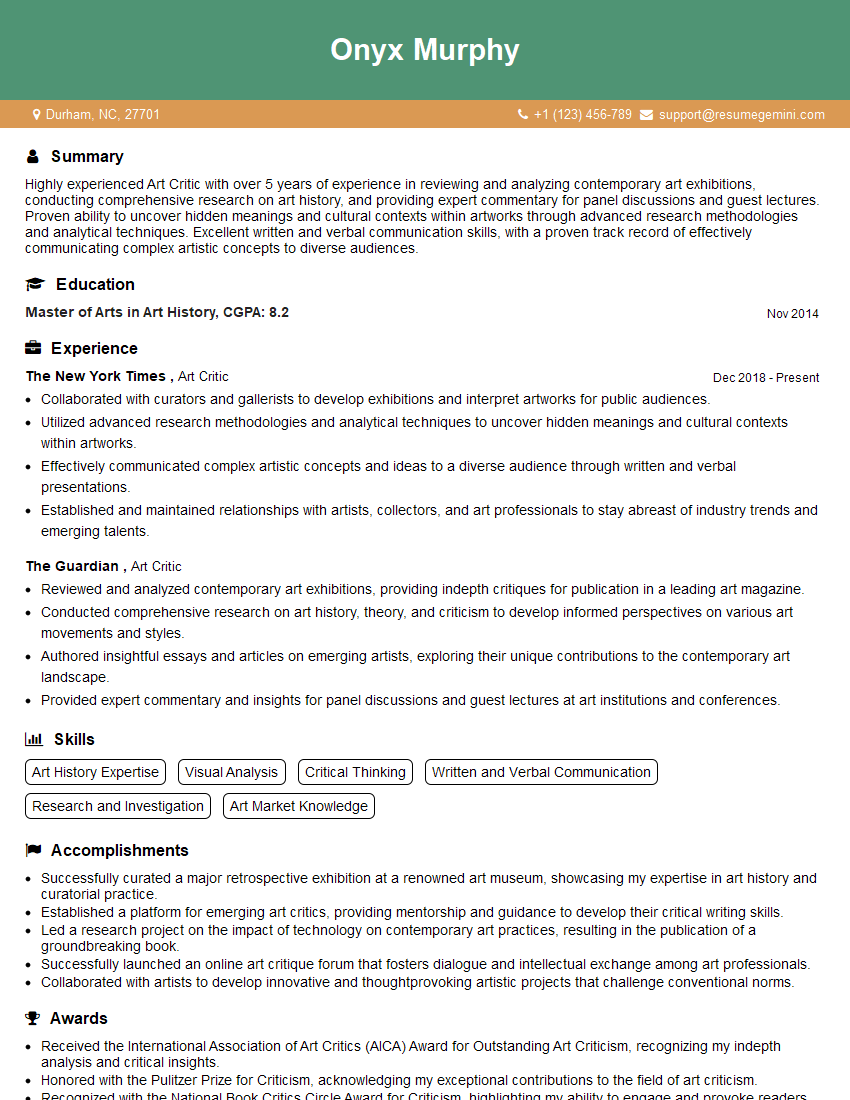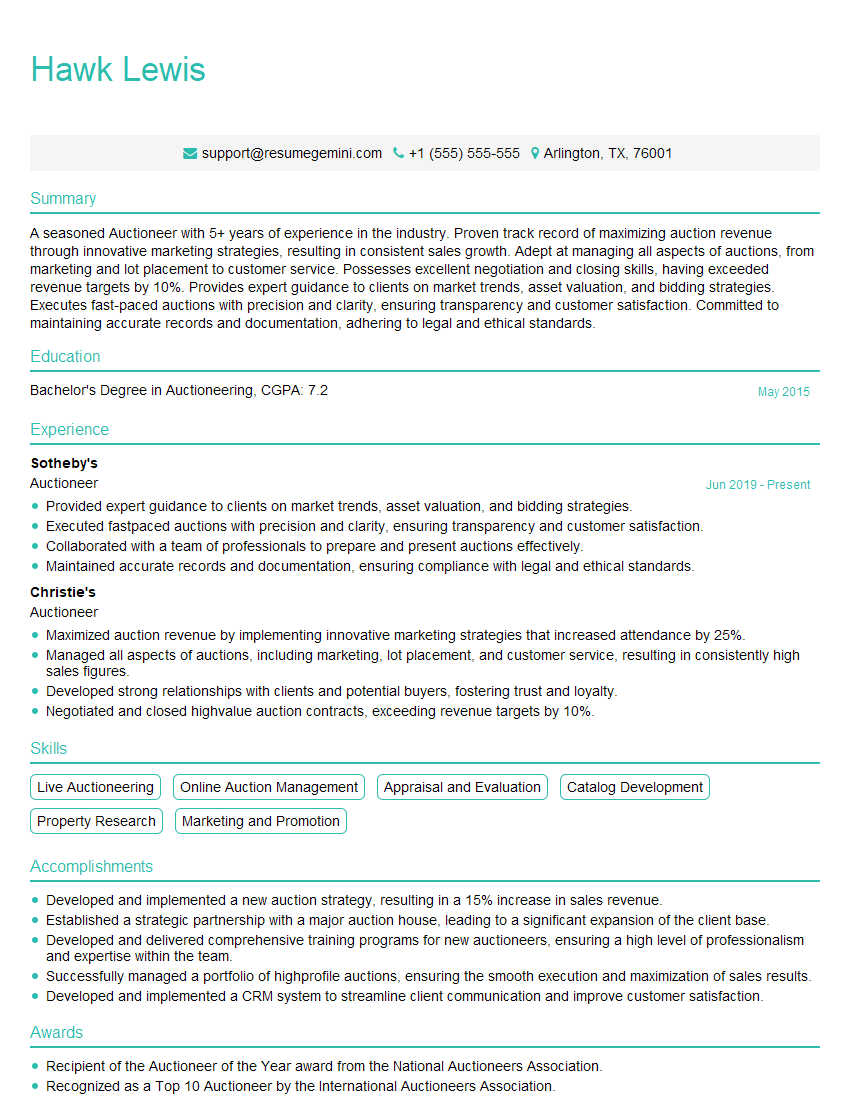Unlock your full potential by mastering the most common Understanding of art history and contemporary art trends interview questions. This blog offers a deep dive into the critical topics, ensuring you’re not only prepared to answer but to excel. With these insights, you’ll approach your interview with clarity and confidence.
Questions Asked in Understanding of art history and contemporary art trends Interview
Q 1. Define ‘modern art’ and its key characteristics.
Modern art, broadly spanning from the late 19th to the mid-20th century, represents a radical departure from traditional artistic conventions. It’s characterized by a rejection of realism and the embrace of experimentation with form, color, and subject matter. Think of it as a rebellion against the established order.
- Abstraction: Many modern artists moved away from representing recognizable objects, focusing instead on abstract forms and exploring the expressive power of color and line. Think of Kandinsky’s non-representational paintings.
- Subjectivity: Modern art emphasizes the artist’s individual expression and perspective, prioritizing feelings and emotions over objective representation. Consider the intensely personal works of Edvard Munch.
- Experimentation with Media: Modern artists experimented with new materials and techniques, pushing the boundaries of what was considered ‘art’. Think of the collage work of Picasso and Braque, or the innovations in sculpture by Constantin Brancusi.
- Challenging Conventions: Modern art questioned traditional notions of beauty and artistic purpose, often acting as a social and political commentary. Think of the political satire in the works of Grosz and Dix.
Understanding modern art requires appreciating this break from the past and recognizing the diverse range of styles and approaches within the movement. It’s not a single style but rather a collection of revolutionary artistic expressions.
Q 2. Discuss the impact of Dadaism on subsequent art movements.
Dadaism, born from the disillusionment of World War I, profoundly impacted subsequent art movements by challenging the very notion of what constitutes art. Its anti-art philosophy, emphasizing absurdity and chance, paved the way for future movements that prioritized experimentation and conceptualism over traditional aesthetics.
- Influence on Surrealism: Dada’s embrace of the irrational and subconscious heavily influenced Surrealism, which explored the world of dreams and the unconscious mind. Artists like André Breton drew heavily from Dada’s techniques and philosophy.
- Conceptual Art’s Precursor: Dada’s focus on the idea behind the artwork rather than its technical execution foreshadowed the rise of Conceptual art, where the concept or idea takes precedence over the finished product.
- Performance and Happenings: Dada’s embrace of unconventional performance and happenings influenced the development of performance art and happenings in the 20th and 21st centuries. The unpredictable and interactive nature of Dada performances paved the way for artists to explore new forms of artistic expression beyond the traditional canvas.
- Rejection of Traditional Aesthetics: Dada’s rejection of traditional artistic values and its celebration of the unconventional laid the groundwork for subsequent avant-garde movements that challenged established norms and pushed creative boundaries.
In essence, Dada didn’t just create art; it redefined what art could be, leaving an indelible mark on the trajectory of modern and contemporary art.
Q 3. Analyze the significance of Minimalism in the context of Post-War art.
Minimalism, a dominant force in Post-War art, reacted against the emotional expressiveness of Abstract Expressionism. It emphasized simplicity, geometric forms, and industrial materials. Think of it as a return to a more stripped-down, essential aesthetic.
- Emphasis on Form and Material: Minimalist artworks focus on the inherent qualities of the materials and their arrangement in space. The emphasis is on the object itself, not on any implied meaning or narrative.
- Rejection of Subjectivity: Minimalism aimed for objectivity, rejecting the emotional expression and subjective interpretation prevalent in Abstract Expressionism. The artwork was meant to be experienced directly, without preconceived notions.
- Influence on Sculpture and Installation Art: Minimalism profoundly impacted sculpture and installation art, prompting a shift towards simpler forms and a more direct engagement with the viewer’s physical experience of the artwork.
- Relationship to the Space: Minimalist artworks often engage directly with the architecture of the space in which they are displayed. The relationship between the object and its surrounding environment is a crucial aspect of the work.
Artists like Donald Judd, Dan Flavin, and Sol LeWitt are key figures in Minimalism. Their work exemplifies the movement’s focus on pure form and its impact on the development of contemporary art.
Q 4. Compare and contrast Impressionism and Post-Impressionism.
Impressionism and Post-Impressionism are closely related yet distinct movements in art history. While Impressionism focused on capturing fleeting moments and the effects of light, Post-Impressionism built upon its foundation but explored more personal expression and subjective interpretations.
- Impressionism: Focused on capturing the immediate visual impression of a scene, emphasizing light, color, and movement. Artists used short, broken brushstrokes to create a sense of vibrancy and spontaneity. Think Monet’s water lilies or Renoir’s depictions of Parisian life.
- Post-Impressionism: Built upon Impressionism’s techniques but moved beyond its emphasis on objective observation. Post-Impressionist artists explored personal expression, subjective perspectives, and symbolic representation. Think of Van Gogh’s impasto technique and expressive use of color, or Cézanne’s exploration of form and structure.
The difference lies in their approach to representation. Impressionists aimed to faithfully capture the visual sensation, while Post-Impressionists used Impressionistic techniques to convey personal feelings and explore deeper meaning. Think of it as Impressionism being the foundation, and Post-Impressionism adding a layer of individual artistic interpretation.
Q 5. Explain the role of patronage in the Renaissance.
Patronage played a crucial role in the Renaissance, acting as the primary driving force behind artistic production. Powerful individuals and institutions commissioned artworks, providing the financial resources and artistic direction that fueled the era’s artistic flourishing.
- The Medici Family: The Medici family in Florence were pivotal patrons, commissioning works from artists like Michelangelo, Leonardo da Vinci, and Botticelli, significantly shaping the artistic landscape of the Renaissance.
- The Church: The Catholic Church served as a major patron, commissioning religious artworks for cathedrals, churches, and chapels. This patronage shaped the iconography and artistic style of religious art during the period.
- Wealthy Merchants and Aristocrats: Wealthy merchants and members of the aristocracy also commissioned portraits, altarpieces, and other artworks, reflecting their social status and artistic preferences.
- Impact on Artistic Development: Patronage not only provided funding but also influenced artistic styles, subjects, and techniques, shaping the direction of artistic development during the Renaissance.
The relationship between artist and patron was complex, often involving negotiations over subject matter, style, and payment. This dynamic significantly contributed to the artistic achievements of the Renaissance, demonstrating how economic support and artistic vision intertwined to shape artistic output.
Q 6. Describe the evolution of photography’s influence on fine art.
Photography’s influence on fine art has been profound and multifaceted, evolving from initial resistance to its full integration into artistic expression.
- Early Influence: Initially, some artists viewed photography as a threat, fearing it would diminish the value of painting. However, many artists began to experiment with photography’s techniques and aesthetic possibilities, exploring its potential for capturing reality and creating new artistic effects.
- Photographic Realism: Some artists embraced photorealism, employing meticulous techniques to create incredibly realistic paintings that mirrored photographic precision. This demonstrated the influence of photography on artistic styles.
- Conceptual Art and Appropriation: Photography became an integral part of conceptual art and appropriation art. Artists used photographs as source material, manipulating and recontextualizing them to create new meanings and challenge traditional notions of authorship and originality.
- Contemporary Practices: Today, photography continues to influence fine art, with many contemporary artists incorporating photographic elements, techniques, and concepts into their works. Artists often blend digital imaging and traditional artistic practices, creating a hybrid approach to image-making.
Photography’s impact on art has been a journey from resistance to integration, ultimately enriching artistic expression and offering artists a new language to explore and convey their vision.
Q 7. What are the current trends shaping the contemporary art market?
The contemporary art market is a dynamic space shaped by various trends that influence artistic production, collecting, and investment.
- Increased Digitalization: The rise of NFTs (Non-Fungible Tokens) and digital art has significantly impacted the art market, creating new avenues for artists to sell their work and for collectors to acquire it. This has broadened the possibilities and accessibility of art.
- Growing Importance of Diversity and Inclusion: There’s a growing demand for works by artists from diverse backgrounds, reflecting a broader societal focus on inclusivity and representation within the art world. This leads to a more equitable and representative range of artistic voices.
- Sustainability Concerns: Sustainability is increasingly a factor in the art market, with collectors and institutions paying greater attention to the environmental impact of art production and distribution. This leads to a focus on eco-friendly materials and practices.
- Focus on Experiential Art: There’s a rising appreciation for immersive and interactive art experiences, such as installations and performance art, reflecting a shift away from purely visual art towards engagement and participation.
- The Metaverse and Virtual Galleries: The metaverse presents new possibilities for exhibiting and selling art, leading to increased opportunities for artists and collectors to interact with art in virtual spaces.
These trends underscore the ongoing evolution of the art market, reflecting broader social, technological, and environmental shifts that are influencing artistic production and appreciation.
Q 8. How has globalization impacted the art world?
Globalization has profoundly reshaped the art world, creating a complex interplay of opportunities and challenges. The increased interconnectedness has led to a significant expansion of the art market, with works and artists from across the globe gaining wider exposure. This has fostered cross-cultural dialogue, resulting in exciting new artistic expressions and hybrid forms. For example, we’ve seen the rise of biennials and art fairs like Art Basel, which showcase artists from diverse backgrounds on a global stage. However, this globalization also brings ethical concerns. The dominance of Western art markets can marginalize artists from less powerful nations, creating imbalances in representation and value.
Furthermore, the ease of global art trafficking has raised concerns about the provenance of artworks and the potential for illicit trade. The rapid spread of information and imagery through the internet has also changed the way art is consumed and disseminated, blurring the lines between the physical and digital art spaces. Artists are navigating this new landscape by exploring digital art forms and engaging with online audiences, while simultaneously grappling with issues like copyright and digital ownership. Think of the impact of NFTs – a completely new art form and market created by this interconnectedness.
Q 9. Discuss the ethical considerations surrounding art authentication.
Art authentication is a critical but ethically complex field. The process of verifying the authenticity of a work of art involves examining various factors, including style, technique, materials, provenance (ownership history), and documentary evidence. However, the high stakes involved – vast sums of money often change hands – introduce ethical dilemmas. For instance, there’s a potential for bias, whether conscious or unconscious, on the part of the authenticator. Their reputation, potential conflicts of interest, and even personal opinions might influence their judgment. Moreover, the scarcity and high value associated with certain artists often incentivize fraudulent activities, making the need for rigorous authentication even more crucial.
Another ethical concern revolves around the lack of transparency and standardization in the authentication process. While some institutions employ rigorous scientific methods, others rely more heavily on subjective expert opinion. This inconsistency can lead to conflicting assessments and disputes. Transparency in methodology and the disclosure of any potential conflicts of interest are crucial for maintaining ethical integrity in this field. The lack of readily available and accessible information about specific techniques and materials can also introduce significant challenges, particularly in cases involving works created with unconventional or now-obsolete materials.
Q 10. Explain the process of appraising a work of art.
Appraising a work of art is a multifaceted process that requires expertise in art history, market trends, and valuation methodologies. It’s more than just assigning a monetary value; it involves a thorough assessment of the artwork’s condition, artistic merit, historical significance, and market demand. The process usually begins with a detailed examination of the artwork itself, documenting its physical characteristics, materials, techniques, and any signs of damage or restoration. Next, research into the artist’s career, comparable works (both in terms of style and market value), and the artwork’s provenance is crucial. This investigation often involves consulting archival records, auction catalogues, and expert opinions.
Once sufficient research is compiled, the appraiser uses various valuation methods, including comparable sales analysis (comparing the artwork to similar pieces sold recently), replacement cost (estimating the cost of recreating the artwork), and income approach (considering the potential rental income or licensing fees from the artwork). The final appraisal report summarizes the findings, detailing the methodology used, and justifying the estimated value. It’s important to remember that an appraisal is an opinion based on available information, and the value of an artwork can fluctuate based on market conditions and changing perceptions of artistic merit. The appraiser’s experience, reputation, and adherence to professional standards are key factors in determining the reliability of the appraisal.
Q 11. Describe your experience with art conservation techniques.
My experience with art conservation techniques spans various approaches, both preventative and interventive. Preventative conservation focuses on minimizing deterioration by controlling environmental factors like temperature, humidity, and light exposure. This involves understanding the materials used in the artwork and developing strategies to protect them from environmental damage. For example, I’ve worked on projects involving the installation of climate-controlled display cases for sensitive works on paper.
Interventive conservation involves the direct treatment of damaged artwork. This ranges from cleaning and stabilizing deteriorated surfaces to repairing tears, losses, and structural damage. I’ve gained experience in several techniques, including surface cleaning using various solvents and tools, consolidation of weak materials with appropriate adhesives, and inpainting to repair losses, which requires matching colours and texture with great precision to maintain the artwork’s aesthetic integrity. Ethical considerations are paramount; the goal is always to minimize intervention, using the least invasive methods possible, while prioritizing the long-term preservation of the artwork. Detailed documentation of all treatment procedures is essential for transparency and future reference. Recent experience includes utilizing digital imaging techniques to document the conservation process and monitor the artwork’s condition over time.
Q 12. How would you curate an exhibition on a specific art movement?
Curating an exhibition on a specific art movement requires a meticulous and research-intensive approach. Let’s say we’re focusing on Surrealism. The initial step would involve defining the scope – what aspects of Surrealism will be emphasized? Will the focus be on the key figures, specific themes, or geographical variations within the movement? Thorough research into the historical context of Surrealism, the key artists and their individual styles, and the artistic influences that shaped the movement would be necessary. This research would inform the selection of artworks and the development of a narrative for the exhibition.
Next, I would identify potential loan sources for artworks – museums, private collections, and galleries. Securing loans often involves lengthy negotiations and careful consideration of insurance and transportation logistics. Once the artworks are secured, the design of the exhibition space is crucial to enhance the narrative flow and visitor experience. Detailed labels and wall texts would provide historical context, biographical information about the artists, and insights into the artworks’ themes and techniques. The exhibition would also benefit from supplementary materials such as catalogues, educational programs, and public lectures to engage a wider audience and deepen understanding of the movement. Finally, evaluating the exhibition’s success through visitor feedback and data analysis would inform future curatorial projects.
Q 13. What strategies would you use to engage diverse audiences in a museum setting?
Engaging diverse audiences in a museum setting requires a multifaceted strategy that goes beyond simply displaying artworks. Firstly, it’s essential to understand the diversity of your community – their cultural backgrounds, interests, and levels of art knowledge. This involves conducting thorough audience research to inform programming decisions. Then, create accessible and inclusive programs, ensuring exhibits, labels, and educational materials cater to visitors with different levels of art experience and different learning styles. This might include offering bilingual labels, audio guides, tactile experiences for visually impaired visitors, and interactive displays for children and families.
Secondly, consider programming initiatives that actively engage different communities through partnerships with local organizations, artists, and community leaders. This could include hosting workshops, artist talks, film screenings, and themed events that resonate with specific cultural groups. Promoting the museum’s diverse programming across various platforms, including social media, local newspapers, and community centers, is also essential to expand reach. Finally, collecting and using visitor data to continuously evaluate and adapt your programs is crucial. Feedback from different community groups can provide valuable insights into how to improve accessibility and create more relevant and engaging experiences for all.
Q 14. How would you handle a dispute between an artist and a gallery?
Handling a dispute between an artist and a gallery requires a delicate and diplomatic approach that prioritizes open communication and a fair resolution. The first step would be to gather all relevant information – the contract between the artist and the gallery, any communication between the parties, and any documentation related to the artwork’s sale or exhibition. Then, I would facilitate a meeting between the artist and gallery owner to discuss the issues in a neutral environment. The goal is to foster a dialogue and understand each party’s perspective.
If mediation fails, alternative dispute resolution methods might be explored, such as arbitration or legal proceedings, but these should be a last resort. Depending on the nature of the dispute, it could involve disagreements over payment, exhibition terms, or the representation of the artist’s work. A fair resolution would consider the contractual agreement, ethical considerations, and the best interests of both the artist and the gallery. It’s crucial to ensure all parties feel heard and that the resolution process is transparent and impartial. Maintaining a professional and respectful approach throughout the process is essential to preserving the working relationship, or to avoid further legal complications.
Q 15. Describe your understanding of art copyright and intellectual property.
Art copyright and intellectual property are crucial aspects of the art world, protecting artists’ rights and ensuring their work is not misused. Copyright, specifically, grants the creator exclusive rights to reproduce, distribute, display, and create derivative works based on their original artistic creations. This protection extends to various forms of art, from paintings and sculptures to digital art and photography. Intellectual property, a broader term, encompasses copyright, but also includes trademarks (protecting brand names and logos) and patents (protecting inventions). For example, an artist holds the copyright to their painting; unauthorized reproduction constitutes copyright infringement. Similarly, an artist’s unique style or recognizable signature could be protected under trademark law. Understanding these legal frameworks is essential for artists, galleries, museums, and collectors to navigate the complexities of art ownership, licensing, and commercialization.
In the digital realm, copyright issues are particularly complex. The ease of reproduction and distribution of digital art makes it crucial to understand the legal implications of sharing, modifying, or selling digital works online. Artists need to actively protect their intellectual property through appropriate licensing agreements and diligent monitoring of online platforms. Cases of plagiarism and unauthorized use of artwork are unfortunately common, highlighting the need for increased awareness and robust legal measures.
Career Expert Tips:
- Ace those interviews! Prepare effectively by reviewing the Top 50 Most Common Interview Questions on ResumeGemini.
- Navigate your job search with confidence! Explore a wide range of Career Tips on ResumeGemini. Learn about common challenges and recommendations to overcome them.
- Craft the perfect resume! Master the Art of Resume Writing with ResumeGemini’s guide. Showcase your unique qualifications and achievements effectively.
- Don’t miss out on holiday savings! Build your dream resume with ResumeGemini’s ATS optimized templates.
Q 16. Analyze the impact of technology on the dissemination and experience of art.
Technology has revolutionized the way art is disseminated and experienced. The internet, in particular, has democratized access to art, allowing for a global audience to engage with works from various periods and styles. Online platforms, museum virtual tours, and high-resolution digital images have overcome geographical barriers and made art accessible to a wider audience than ever before. For example, the Google Arts & Culture project allows users to virtually explore famous museums worldwide and examine artwork in detail. This accessibility fosters broader appreciation and understanding of art history.
Moreover, technology has enabled new forms of artistic expression. Digital art, interactive installations, and virtual reality experiences are blurring the boundaries between traditional art forms and technology, creating immersive and engaging artworks. Consider the use of augmented reality (AR) apps that overlay digital information onto physical artworks, enriching the viewer’s experience. The combination of technology and art has opened up exciting new possibilities for creative exploration and engagement.
However, the digitalization of art also raises concerns about ownership, authenticity, and the potential for misuse. The ease of duplication and modification of digital art presents challenges for copyright protection and the preservation of artistic integrity.
Q 17. Discuss the role of social media in contemporary art promotion.
Social media has become an indispensable tool for promoting contemporary art. Platforms like Instagram, Facebook, and TikTok provide artists with direct access to a vast global audience, bypassing traditional gatekeepers like galleries and critics. Artists can showcase their work, engage directly with potential collectors and viewers, and build their brand through curated feeds, behind-the-scenes glimpses into their creative process, and interactive content. Think of the rise of artists who have achieved significant success and recognition primarily through their savvy use of social media marketing strategies.
However, the effectiveness of social media promotion requires a strategic approach. Artists need to cultivate a strong online presence, curate their content carefully, and actively engage with their audience. Utilizing relevant hashtags, collaborating with other artists or influencers, and running targeted advertising campaigns can significantly amplify reach and impact. Moreover, understanding the nuances of different social media platforms and tailoring content accordingly is critical for successful promotion. Simply posting images isn’t enough; engaging storytelling, insightful captions, and visually appealing content are crucial.
It’s also crucial to recognize that social media can be a double-edged sword. The constant pressure to maintain an online presence, the potential for negative comments or criticism, and the challenge of navigating the ever-evolving algorithms can be overwhelming for artists.
Q 18. How do you approach researching and writing about art?
My approach to researching and writing about art is multifaceted and rigorous. It begins with a deep dive into the artwork itself, engaging with its visual elements, materials, and context. This involves careful observation, meticulous documentation, and sometimes, even handling the artwork (if possible and appropriate). Next, I extensively research the artist’s biography, influences, and creative evolution. This often requires consulting archival materials, reading scholarly articles and books, and sometimes conducting interviews with the artist or their associates.
Contextual research is equally vital. I examine the historical, social, and cultural factors that shaped the artwork’s creation and reception. This might involve exploring relevant historical events, social movements, or artistic trends. For instance, analyzing a 1960s Pop Art piece requires understanding the cultural impact of consumerism and mass media at the time. I also consider the artwork’s reception history, studying critical reviews, exhibition catalogues, and auction records to understand its impact on the art world.
Finally, I synthesize my research into a cohesive narrative, structuring my writing to convey the artwork’s significance and relevance clearly and engagingly to my audience. I always strive for a balance between factual accuracy and insightful interpretation, aiming to provide readers with a comprehensive and nuanced understanding of the artwork and its context.
Q 19. Explain your understanding of different art collecting strategies.
Art collecting strategies vary widely, depending on individual goals, resources, and aesthetic preferences. Some collectors focus on building a comprehensive collection spanning different periods, styles, or movements, aiming for historical depth and breadth. Others might specialize in a particular artist, movement, or medium, striving for depth of knowledge within a niche area. For example, a collector might focus exclusively on Impressionist paintings or contemporary photography.
Another common strategy involves thematic collecting, where works are chosen based on a unifying theme or concept. This could be anything from depictions of nature to social commentary. A collector might focus solely on art that addresses environmental issues. Financial investment is also a significant factor for some collectors. These investors approach art collecting as an investment opportunity, seeking works with high appreciation potential. Their strategies involve analyzing market trends, artist reputations, and auction history to make informed investment decisions.
Beyond these strategic approaches, many collectors are driven by personal passion and aesthetic appreciation. They acquire art that resonates with their individual tastes and interests, regardless of market value or investment potential. A holistic collecting strategy ideally integrates both strategic and personal motivations, combining a keen eye for artistic merit with an understanding of the market and the potential for appreciation.
Q 20. Discuss the importance of art criticism in shaping public perception.
Art criticism plays a vital role in shaping public perception of art. Critics act as intermediaries, interpreting and evaluating artwork for a wider audience. They provide context, offer different perspectives, and help viewers understand and appreciate artistic choices. A well-written critical review can significantly influence how an artwork is received, bringing attention to underappreciated artists or challenging conventional viewpoints.
However, the influence of art criticism is not without its complexities. Critics’ perspectives are subjective and influenced by personal biases, cultural contexts, and theoretical frameworks. Different critics might interpret the same artwork vastly differently, leading to diverse and sometimes conflicting interpretations. Moreover, the power dynamics within the art world can affect critical reception. Established critics might hold more sway than emerging voices, potentially marginalizing certain artists or perspectives.
Nevertheless, art criticism remains a valuable tool for fostering dialogue, promoting critical thinking, and enriching public engagement with art. Exposure to diverse critical perspectives encourages viewers to actively engage with artwork, forming their own interpretations and developing a more sophisticated understanding of artistic expression.
Q 21. What are the major auction houses and their impact on the art market?
Major auction houses, such as Sotheby’s, Christie’s, and Phillips, play a dominant role in the global art market. They facilitate the buying and selling of high-value artworks, setting prices and influencing market trends. These houses provide platforms for artists, galleries, and collectors to engage in the auction process, offering expertise in appraisal, authentication, marketing, and logistics.
The impact of these auction houses is significant. Auction records often set benchmarks for artist values and influence subsequent sales prices. Their sales catalogues and marketing efforts enhance visibility and recognition for artists and their works, boosting market demand. However, their role is not without criticism. Concerns have been raised regarding transparency, ethical practices, and the concentration of power within the art market. The high fees charged by auction houses and their tendency to favor established artists also raise questions of inclusivity and access for emerging artists.
Despite these criticisms, auction houses remain key players in the art world, shaping market trends, setting prices, and disseminating art to collectors worldwide. Understanding their role is critical for anyone involved in the art market, from artists to collectors and art historians.
Q 22. Describe your experience working with art databases and archives.
My experience with art databases and archives is extensive. I’ve worked with both large-scale institutional repositories like the Getty Research Institute’s online collections and smaller, specialized archives focusing on specific movements or artists. This involved not only navigating complex search functionalities – understanding Boolean operators and metadata schemas is crucial – but also critically evaluating the information retrieved. For example, I once used the Smithsonian Archives of American Art’s online resources to research the use of collage in 1920s American art. The database’s robust search capabilities, coupled with its detailed provenance information, allowed me to identify lesser-known artists who significantly contributed to the development of the technique. Beyond searching, I’m proficient in data entry, metadata creation, and archival preservation best practices, ensuring the long-term accessibility and integrity of digital collections. I also have experience with image analysis software, allowing me to identify and catalog artwork based on stylistic features and technical characteristics. This experience translates directly to efficient research and accurate data management within an art-related professional environment.
Q 23. Explain your familiarity with different art materials and techniques.
My familiarity with art materials and techniques spans a wide range, from traditional methods to contemporary practices. I understand the properties of pigments, binders, and supports used in painting (oil, watercolor, acrylic, tempera, fresco), sculpture (bronze casting, stone carving, wood carving, assemblage), printmaking (engraving, etching, lithography, screen printing), and drawing (charcoal, pastel, graphite, pen and ink). I’m also knowledgeable about contemporary media, such as digital art, video art, installation art, performance art, and mixed media, understanding the unique technical challenges and aesthetic considerations associated with each. For example, while researching the works of Yayoi Kusama, I gained a deep appreciation for the meticulous process of her Infinity Mirror Rooms – the interplay of light, mirrors, and spatial perception. Furthermore, I understand the significance of material choice in conveying meaning and artistic intent. Recognizing the subtle differences between, say, a charcoal sketch and a finely rendered pastel drawing, is crucial to accurate art historical analysis and informed curatorial practice. My knowledge extends to conservation techniques, recognizing the importance of preserving artworks across diverse materials and historical periods.
Q 24. How would you develop a marketing plan for a new art exhibition?
Developing a marketing plan for a new art exhibition requires a multi-faceted approach. First, I would define the target audience – are we targeting seasoned art collectors, a younger demographic interested in contemporary art, or a broader public? Once defined, I would tailor the marketing message accordingly. This involves creating compelling visuals and textual descriptions that highlight the unique selling points of the exhibition – the artist’s renown, the historical significance of the works, or the thematic focus, for instance. My strategy would leverage a variety of channels:
- Social Media Marketing: Engaging content across platforms like Instagram, Facebook, and Twitter with high-quality images, behind-the-scenes glimpses, and artist interviews.
- Public Relations: Press releases to art publications, local media, and blogs, along with cultivating relationships with influential art critics and bloggers.
- Website and Email Marketing: A dedicated exhibition webpage with ticketing information, artist bios, and high-resolution images, complemented by targeted email campaigns to mailing lists.
- Collaborations: Partnering with local businesses, hotels, and other cultural institutions to cross-promote the exhibition.
- Event Marketing: Organizing opening receptions, artist talks, workshops, or guided tours to enhance audience engagement.
Throughout the process, analytics will be crucial – tracking website traffic, social media engagement, and ticket sales to assess the effectiveness of the campaign and make adjustments as needed. A successful marketing plan is iterative, responding to data and evolving audience feedback.
Q 25. Describe a challenging situation you faced in an art-related context and how you resolved it.
During a collaborative project cataloging a private art collection, we encountered a significant challenge: the lack of consistent documentation for many of the works. Some pieces were missing provenance information, others had conflicting data across different sources, creating significant hurdles in accurately describing and cataloging the collection. To resolve this, I implemented a multi-step approach. First, I organized the existing fragmented documentation, identifying discrepancies and inconsistencies. Then, I developed a standardized data entry system, establishing clear guidelines for recording provenance, materials, and condition reports. We also employed rigorous cross-referencing techniques, verifying information across various sources (auction catalogs, artist records, and expert opinions) whenever possible. Finally, to supplement missing information, I conducted extensive archival research, using online databases and contacting experts in the field. This systematic approach ensured the final catalog was reliable and accurate, despite the initial challenges. The experience honed my skills in problem-solving, data management, and collaborative teamwork within a demanding project timeline.
Q 26. How do you stay informed about current art trends and developments?
Staying abreast of current art trends requires a multifaceted approach. I regularly visit museums and galleries both physically and virtually, attending exhibitions and noting curatorial trends. I subscribe to art magazines (Artforum, Frieze, Art in America) and follow leading online art publications and blogs. I actively participate in online art communities and forums, engaging in discussions with fellow professionals and artists. I also follow influential art critics and curators on social media, keeping track of their commentaries and exhibition reviews. Further, I attend art fairs (Art Basel, Frieze London) and conferences, networking with professionals and gaining firsthand exposure to new artistic developments. The key is to maintain a balanced approach, engaging with a variety of sources to gain a holistic understanding of emerging trends and their historical context.
Q 27. What are your salary expectations for this role?
My salary expectations for this role are commensurate with my experience and expertise in the field, aligning with the industry standard for professionals with my qualifications and track record. I am open to discussing a competitive compensation package that reflects the scope and responsibilities of the position.
Q 28. Why are you interested in this specific position?
I am highly interested in this specific position because it offers a unique opportunity to combine my passion for art history and contemporary art with my practical skills in research, data management, and marketing. The chance to contribute to [mention specific aspects of the role or organization that appeal to you, e.g., a groundbreaking exhibition program, a prestigious institution’s collection, a dynamic team environment] is particularly exciting. I believe my skills and experience align perfectly with the requirements of this role, and I am confident that I can make significant contributions to your team’s success.
Key Topics to Learn for Understanding of Art History and Contemporary Art Trends Interview
- Major Art Historical Movements: Develop a strong understanding of key periods and styles (e.g., Renaissance, Baroque, Impressionism, Modernism, Postmodernism) including their defining characteristics, key artists, and socio-cultural contexts.
- Contemporary Art Trends: Familiarize yourself with current trends, including conceptual art, installation art, performance art, digital art, and their theoretical underpinnings. Be prepared to discuss specific artists and movements shaping the contemporary art landscape.
- Art Theory and Criticism: Grasp fundamental art theoretical concepts (e.g., aesthetics, semiotics, formalism, post-structuralism) and be able to apply them to analyze and interpret artworks. Practice articulating your own critical perspectives.
- Art History’s Impact on Society: Explore the social, political, and economic influences on art throughout history and how these factors continue to shape contemporary artistic practices. Understand art’s role in cultural dialogue and social change.
- Museum and Gallery Practices: Develop familiarity with the workings of museums and galleries, including curation, exhibition design, collection management, and audience engagement. This demonstrates practical understanding beyond theoretical knowledge.
- Analyzing Visual Culture: Go beyond fine art and consider broader visual culture, including advertising, design, and media. Understanding the visual language of various mediums strengthens your analytical skills.
Next Steps
Mastering art history and contemporary art trends is crucial for career advancement in the art world, whether you’re aiming for curatorial roles, art criticism, gallery management, or art education. A strong understanding of these areas demonstrates a deep appreciation for art and the ability to critically engage with it. To significantly boost your job prospects, focus on creating an ATS-friendly resume that highlights your relevant skills and experiences. ResumeGemini is a trusted resource to help you build a professional and effective resume that will catch the eye of potential employers. Examples of resumes tailored to roles requiring an understanding of art history and contemporary art trends are available to help guide you.
Explore more articles
Users Rating of Our Blogs
Share Your Experience
We value your feedback! Please rate our content and share your thoughts (optional).
What Readers Say About Our Blog
Hello,
We found issues with your domain’s email setup that may be sending your messages to spam or blocking them completely. InboxShield Mini shows you how to fix it in minutes — no tech skills required.
Scan your domain now for details: https://inboxshield-mini.com/
— Adam @ InboxShield Mini
Reply STOP to unsubscribe
Hi, are you owner of interviewgemini.com? What if I told you I could help you find extra time in your schedule, reconnect with leads you didn’t even realize you missed, and bring in more “I want to work with you” conversations, without increasing your ad spend or hiring a full-time employee?
All with a flexible, budget-friendly service that could easily pay for itself. Sounds good?
Would it be nice to jump on a quick 10-minute call so I can show you exactly how we make this work?
Best,
Hapei
Marketing Director
Hey, I know you’re the owner of interviewgemini.com. I’ll be quick.
Fundraising for your business is tough and time-consuming. We make it easier by guaranteeing two private investor meetings each month, for six months. No demos, no pitch events – just direct introductions to active investors matched to your startup.
If youR17;re raising, this could help you build real momentum. Want me to send more info?
Hi, I represent an SEO company that specialises in getting you AI citations and higher rankings on Google. I’d like to offer you a 100% free SEO audit for your website. Would you be interested?
Hi, I represent an SEO company that specialises in getting you AI citations and higher rankings on Google. I’d like to offer you a 100% free SEO audit for your website. Would you be interested?
good

